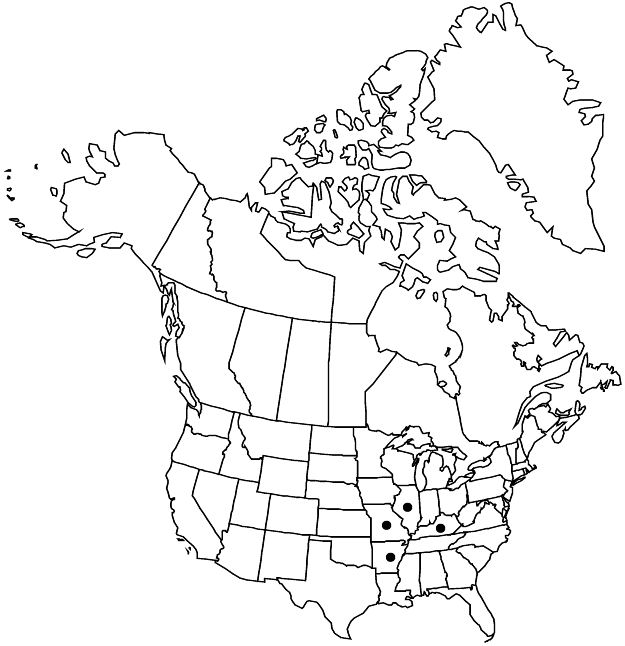Difference between revisions of "Crataegus fecunda"
Bot. Gaz. 33: 111. 1902.
FNA>Volume Importer |
imported>Volume Importer |
||
| (6 intermediate revisions by 2 users not shown) | |||
| Line 32: | Line 32: | ||
|distribution=Ark.;Ill.;Ky.;Mo. | |distribution=Ark.;Ill.;Ky.;Mo. | ||
|discussion=<p>Of conservation concern.</p><!-- | |discussion=<p>Of conservation concern.</p><!-- | ||
| − | --><p>Crataegus fecunda was formerly found in the central United States, mainly near the Mississippi and Ohio rivers. It has apparently not been seen in the wild since the 1930s, an example of the decline of previously well-documented taxa, some of which are seemingly extinct.</p><!-- | + | --><p><i>Crataegus fecunda</i> was formerly found in the central United States, mainly near the Mississippi and Ohio rivers. It has apparently not been seen in the wild since the 1930s, an example of the decline of previously well-documented taxa, some of which are seemingly extinct.</p><!-- |
| − | --><p>Crataegus fecunda is similar to glabrous-inflorescence forms of C. persimilis; it always has sharper and more prominent leaf marginal teeth, usually proportionately narrower leaves with more acute apices, slightly hairy inflorescences, and plane-sided pyrenes. According to Sargent, it had fruit 22–25 mm diam.</p><!-- | + | --><p><i>Crataegus fecunda</i> is similar to glabrous-inflorescence forms of <i>C. persimilis</i>; it always has sharper and more prominent leaf marginal teeth, usually proportionately narrower leaves with more acute apices, slightly hairy inflorescences, and plane-sided pyrenes. According to Sargent, it had fruit 22–25 mm diam.</p><!-- |
| − | --><p>Crataegus shinnersii Kruschke, known from a handful of specimens in Wisconsin, is similar and would key here but has cream or ivory anthers and glabrous inflorescences; its precise taxonomic disposition is uncertain.</p> | + | --><p><i>Crataegus</i> shinnersii Kruschke, known from a handful of specimens in Wisconsin, is similar and would key here but has cream or ivory anthers and glabrous inflorescences; its precise taxonomic disposition is uncertain.</p> |
|tables= | |tables= | ||
|references= | |references= | ||
| Line 43: | Line 43: | ||
-->{{#Taxon: | -->{{#Taxon: | ||
name=Crataegus fecunda | name=Crataegus fecunda | ||
| − | |||
|authority=Sargent | |authority=Sargent | ||
|rank=species | |rank=species | ||
| Line 58: | Line 57: | ||
|publication year=1902 | |publication year=1902 | ||
|special status=Conservation concern;Endemic | |special status=Conservation concern;Endemic | ||
| − | |source xml=https:// | + | |source xml=https://bitbucket.org/aafc-mbb/fna-data-curation/src/2e0870ddd59836b60bcf96646a41e87ea5a5943a/coarse_grained_fna_xml/V9/V9_912.xml |
|subfamily=Rosaceae subfam. Amygdaloideae | |subfamily=Rosaceae subfam. Amygdaloideae | ||
|tribe=Rosaceae tribe Gillenieae | |tribe=Rosaceae tribe Gillenieae | ||
Latest revision as of 23:00, 5 November 2020
Trees, 60–80 dm. Stems: trunks to 3 dm diam.; twigs: new growth dark green turning orange, lustrous, pilose, 1-year old orange-brown, older ashy gray; thorns on twigs ± straight to recurved, 1-year old chestnut or blackish brown, slender, 5–6.5 cm. Leaves: stipules stipitate, linear to semilunate, 1.3–2 cm, coarsely glandular-serrate; petiole ± winged apically, 13–20 mm, stout, length 26–31% blade, adaxially grooved, villous, often scattered dark glandular; blade pale yellow-green abaxially, dark green when mature, red in fall, oblong-obovate to ovate or broadly ovate, 5–6.5 cm, thin and firm, base gradually or abruptly narrowed, obscurely ciliate, lobes 0, margins usually doubly, coarsely serrate (except proximally), teeth spreading, 2–3 mm, glandular, venation craspedodromous, midvein stout, veins 7–9 per side, remote, only slightly impressed adaxially, apex acute, rarely rounded, short-pointed, lustrous, adaxial scabrous young, scabrous or glabrous mature, midveins and primary veins villous with occasional white hairs. Inflorescences 6–17-flowered; branches sparsely villous; bracteoles linear to oblong-obovate, margins sparsely glandular-serrate. Flowers 18 mm diam.; hypanthium ± villous; sepals spreading after anthesis, elongated, shorter than petals, margins subentire or shallowly to deeply glandular-serrate, stipitate-glandular, apex acuminate, abaxially villous; stamens 10(–15), anthers dark purple, small; styles 2 or 3. Pomes borne in wide, drooping, multi-fruited glabrous clusters, dull orange-red, with dark lenticels, short-oblong to suborbicular ends full, rounded, 13 mm diam., sparsely hairy until nearly fully grown; flesh pale green, thick, firm, hard, dry, sweet; sepals erect, incurved, linear-lanceolate, coarsely glandular-serrate above middle; pyrenes 2 or 3, rounded, 8 mm.
Phenology: Flowering Apr; fruiting Sep–Oct.
Habitat: Ravines, brush, rich woodlands, near streams
Elevation: 50–200 m
Distribution

Ark., Ill., Ky., Mo.
Discussion
Of conservation concern.
Crataegus fecunda was formerly found in the central United States, mainly near the Mississippi and Ohio rivers. It has apparently not been seen in the wild since the 1930s, an example of the decline of previously well-documented taxa, some of which are seemingly extinct.
Crataegus fecunda is similar to glabrous-inflorescence forms of C. persimilis; it always has sharper and more prominent leaf marginal teeth, usually proportionately narrower leaves with more acute apices, slightly hairy inflorescences, and plane-sided pyrenes. According to Sargent, it had fruit 22–25 mm diam.
Crataegus shinnersii Kruschke, known from a handful of specimens in Wisconsin, is similar and would key here but has cream or ivory anthers and glabrous inflorescences; its precise taxonomic disposition is uncertain.
Selected References
None.